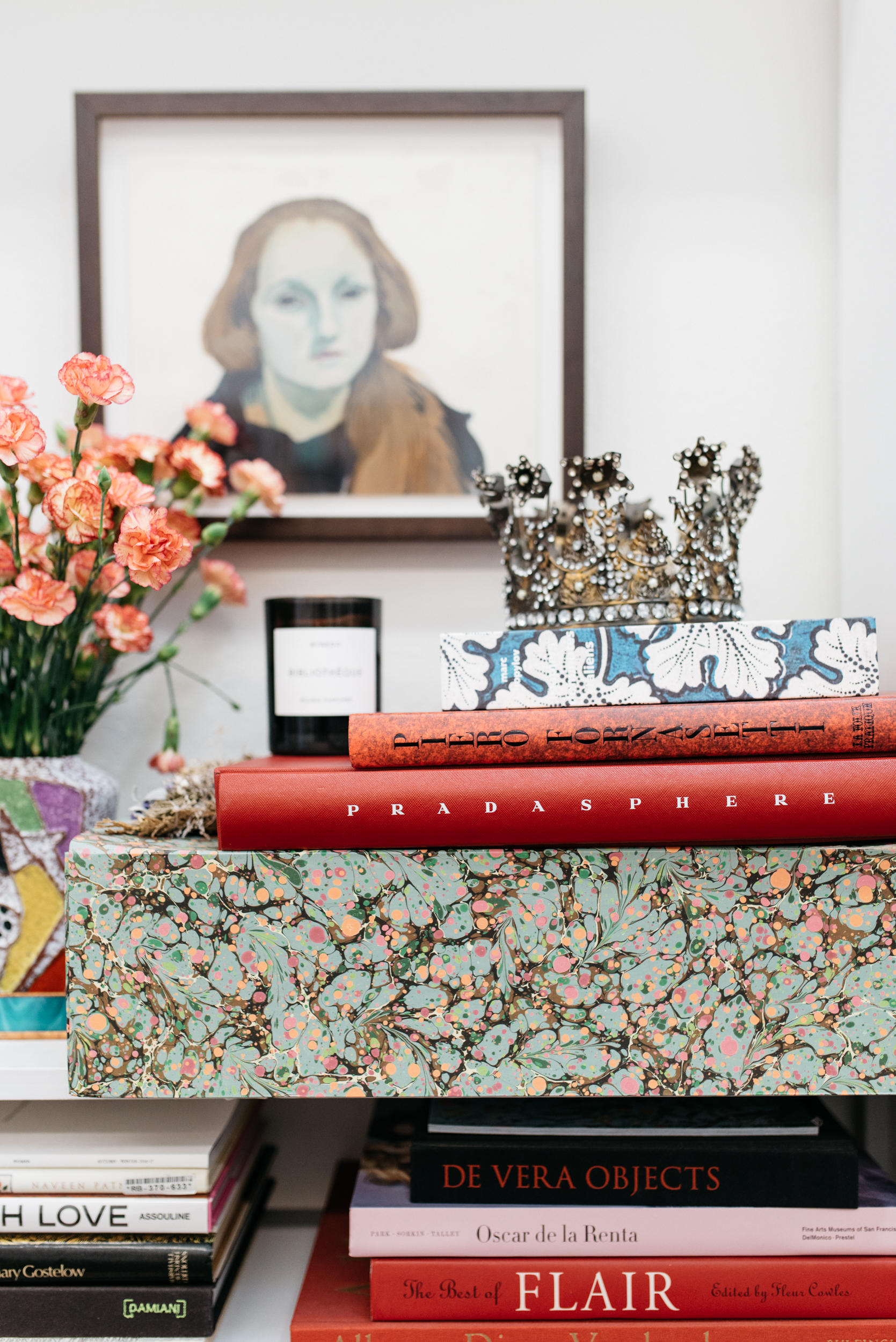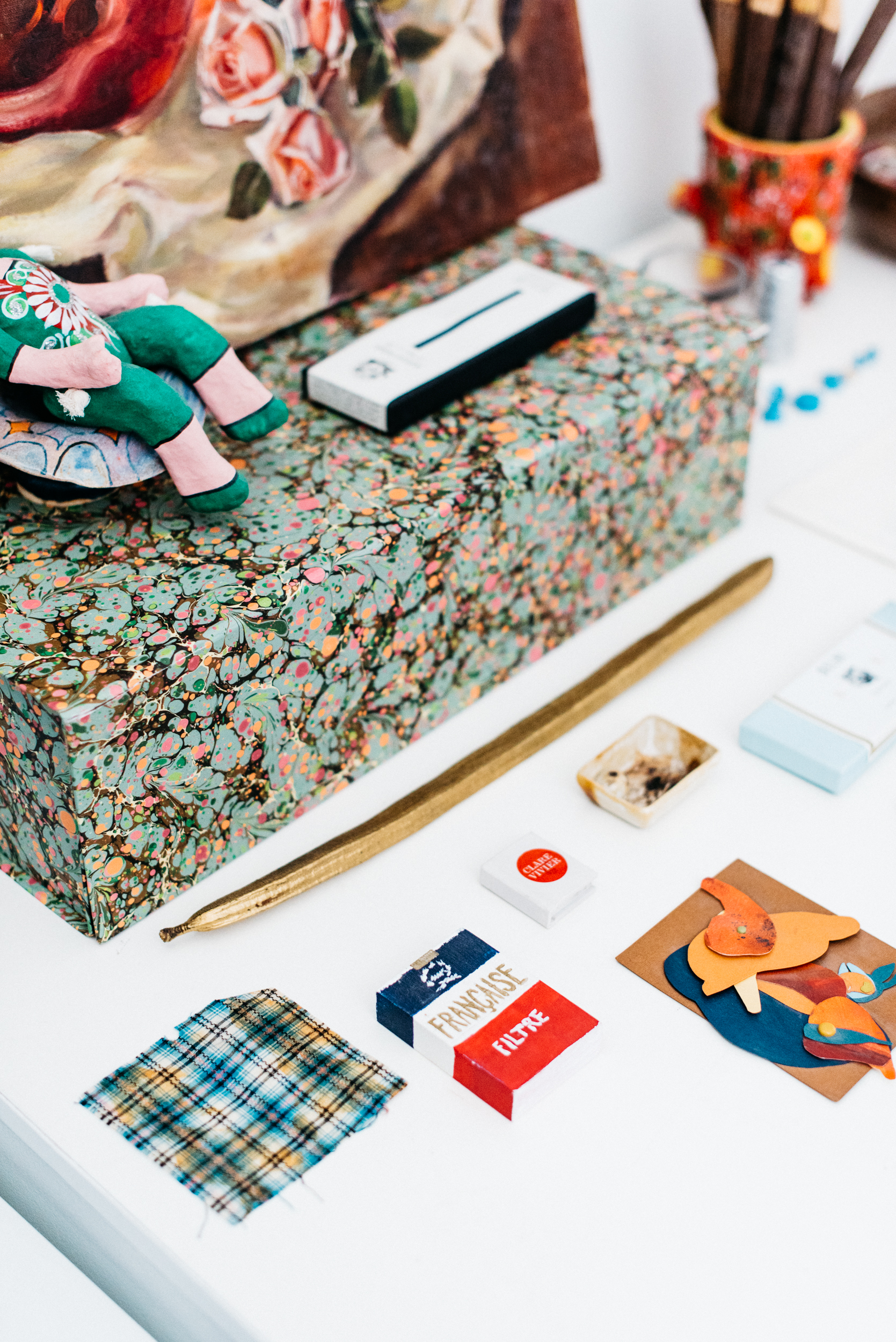
Joanna Williams
photography by: Cara Robbins
As a seeker of stories, Joanna Williams has traveled the world over to gather richness from around the globe. We stepped inside the box of treasures, that is her office to find out more of her story and how she found herself on the path to create Kneeland & Co.
Girls At Library: What was the name of the first book you fell in love with, that turned you into a lifelong reader?
Joanna Williams: Ramona Forever by Beverly Cleary and the Sweet Valley Twins series by Francine Pascal. Those are the actual titles that come to mind first, but my earliest memory of falling in love with books and reading is when I would spend weekends at my grandparents. They had floor to ceiling bookshelves, and a few of those bottom shelves were reserved for the grandkids. I spent hours on the floor by those bookshelves looking at all the spines, flipping through imagery, and eventually reading - which apparently happened in that exact spot. My grandfather recently told me that I taught myself how to read when I was really small. I was staring at a page one afternoon and he walked past me and asked, “What’s that you’re doing?”. My response was reading the entire page to him.
GAL: What is the power of story? Describe some ways in which fictional narratives have impacted you and your life.
JW: I think the power of story lies in discovering how other people live. I’m not one to read an easy breezy, surface-level book. I know some people like to check out on occasion and read something that doesn’t dive deep into life, and while I totally get it and should probably read more of those types of books, I tend to gravitate towards a story that has a profound life message. I think human nature can often make one feel disconnected or as if no one else can relate to problems or issues we experience on an individual level, but reading a really good story told through a writer’s perspective can feel very calming and freeing. I’m a very nostalgic person, and I tend to hold onto fictional narratives in both literature, film, and music. Less Than Zero by Bret Easton Ellis is a story I discovered when I was young and all I could think about for years was wanting to live during that time and be a part of that cool group of new wave misfits.
GAL: I know rugs typically tell a story. Are there similar stories told through textiles? What kind of stories do textile makers tell?
JW: Many of the same stories told through rugs are also told through various other textiles. In indigenous communities, for example, a motif on a textile may refer to someone’s marriage, family, religious practice, or even something as simple as a daily routine.
GAL: You’ve mentioned that India is your favorite country to visit. Do you have any particular textile art pieces you received or purchased there that have significant meaning?
JW: I became very fascinated with Tantra Art (yantra symbols, in particular) a few years ago and have been on a mission to acquire a collection of yantra paintings. I’ve started collecting them and purchasing old books by Ajit Mookerjee, who was an Indian author and tantra art specialist. I’ve brought home a few of his books from India, as well as rare books on Indian textiles.
GAL: What is it about India that has stolen your heart?
JW: India is an entirely different planet! It is so far beyond what is considered ‘normal’ in the US, and it is the country that has had the biggest impact on me when it comes to self-realization and self-actualization. I always tell others that if you really want to learn who you are, visit India for a few weeks. The level of over-stimulation is intoxicating to me, and the history of craft and food and design and architecture is on another level. There is an energy there that grabs you by the heart.
GAL: Another favorite place you mention is Mexico City. What do you love to do while you’re there?
JW: Having long lunches with my family, sourcing textiles and furniture from antique dealers, and experiencing all there is to eat! I usually wake up early and head to my favorite bakery for tea and pan dulce, do some shopping or visit a museum, have a long lunch with some mezcal and micheladas, visit friends or walk around the city admiring the colonial buildings, and then have a late dinner at one of my favorite restaurants.
GAL: How often do you read?
JW: I go back and forth between magazines, the internet, and books. I definitely read everyday, but I can’t seem to ever keep up with my stacks and my inbox!
GAL: Who is your favorite author? (If impossible to choose please name two.)
JW: Judy Blume forever.
GAL: We have a friend who has a “Sanity Shelf,” which is dedicated to books she returns to again and again to read for pleasure, knowledge, and solace. What would be on your shelf?
JW: I love that. I would probably say Creative Visualization. That book really had a huge impact on me when I first read it. It really changed my life. I’ve read it over and over and I definitely go to it for pleasure, comfort, and knowledge.
GAL: That’s a great book to re-read because you can always discover something new in it.
JW: It’s true, you always find something new. It very much feels like a life lesson book. It’s interesting because going back to read it over the years, I notice how far I’ve come, and then I also discover something new, or I read a paragraph or a chapter and it feels different from the last time. It often feels like I have gained more clarity on the topic that she’s discussing. It feels like this thing that is part of my personal growth, and I feel like it will always resonate with me, no matter how old I am.
GAL: Which is amazing.
JW: Yeah, totally. And it’s not a story, by any means, as much as I love stories. It’s more just pleasure, just the pure pleasure of getting to know yourself even better.
GAL: It’s wonderful that a book can help you do that. Is there anything else that would be on your Sanity Shelf?
JW: I don’t re-read many books. The one book I might read again is Just Kids. It had a really huge impact on me when I first read it. I was new in my business when it came out, was traveling in Big Sur, it was really comforting, and I could not put it down. It was a really powerful trip, that trip in particular — Big Sur is one of the most powerful places on the Earth. So I have a very special soft spot for that book. It contains the most incredible storytelling, and there’s so much about human connection wrapped in it. It was both sad and inspiring, which I think is a really hard thing to achieve in a book in equal amounts.
GAL: I haven’t read that yet, but now I feel like I must read it.
JW: I love any story that’s about human connection, and that book is the epitome of it. Patti Smith is an amazing storyteller through her music and everything. I also love Jane Austen. I had started a Jane Austen book club years ago, and it only went on for about six months until like in a usual book club, people started dropping off. I also love—well, I can’t believe I forgot about this, but the Cheryl Strayed book Tiny Beautiful Things, that book is like forever and ever and ever on my bookshelf. That is something I’ll return to. And talk about human connection. Have you read it?
GAL: I haven’t, no!
JW: That is definitely one of my favorite books. She was an advice column writer for this tiny paper, and her alias was “Sugar” and she had this column called “Dear Sugar,” so people would write from everywhere. The column consisted of really intense confessions and situations and predicaments— really heavy— and her responses. I swear to God, it’s the one book that every human being on planet Earth should read.
GAL: Interesting! It sounds great.
JW: Yeah, it’s incredible. So I would say Creative Visualization, Patti Smith’s Just Kids, Cheryl Strayed’s Tiny Beautiful Things, and I don’t really have a favorite Jane Austen—but you’re welcome to put any Jane Austen on there [laughs]. I feel like I can read Jane Austen all the time, over and over.
GAL: Do you have a favorite author?
JW: I’m a huge Joan Didion fan. I love Play It As It Lays. The book and the movie. I don’t know if you ever saw the movie, it’s incredibly hard to find. But the movie’s incredible—it’s beautifully shot, the styling is amazing, shot in the seventies in Malibu. I rented it like seven years ago at that rare video store in West L.A., Vidiots. I’m a huge Joan Didion fan. Most women are.
GAL: I haven’t read that much Joan Didion. The Didion I have read I really love, but I haven’t explored all of her works because I feel like—people love her work so much, it almost makes it feel wrong.
JW: I know, that’s why I was so hesitant to add her as a favorite author because I know I’ll be the hundredth girl who’s like, “Joan Didion!”
GAL: She’s a thoughtful and curious writer who has consistently struck upon something that connects with every woman.
JW: I know, it’s really interesting. I think she has a way about sorrow, and not even so much writing about happiness. I think a lot of women connect with how solemn she is, and how very raw with her work she is. And in these really difficult moments of her life, she finds this deep, not even so much of a meaning to it, but she uses words to describe her feelings around a certain situation, and she doesn’t always make perfect sense of them. Like there’s no conclusion to it, I guess. So I don’t know if that’s why so many women connect to her, but it is so many generations, you know. And so many women in California especially connect with her, well bi-coastal really, because she had her New York life and her California life. So I think it’s like, so much of her writing is wrapped up in these places, and the way she talks of them and her love for them and her disdain for them, you know, I think it’s very relatable to a lot of people.
GAL: Where do you read? Do you have a favorite reading spot, or can you read anywhere?
JW: I read anywhere! I mean, when I’m travelling I’m reading anywhere, like on a plane or wherever I am. But I can pretty much read anywhere. I read a lot in bed and on the couch.
GAL: A comfortable couch?
JW: Yeah, a big, comfy, long couch.
GAL: How do you choose the books you read?
JW: Recommendations, either by friends or online or print reviews.
GAL: Do you prefer holding a book to devices? Or do you use a device?
JW: I don’t read any books on devices. I hold the book [laughs]. Holding books only.
GAL: When you’re looking for books while you’re travelling, what do you look for?
JW: Usually rare art, fashion, and textile books.
GAL: Do you have a favorite object that you’ve found while travelling?
JW: Oh my god. That’s so hard to answer. Well, one of my favorite stores in the world is called Monograph Books and Objects in Portland that my friends Blair and John run. They just have an incredible eye for old things like ephemera and books, and rare and out of use art books. They introduced me to the tantra art book by Ajiat Mookerjee, and it really ignited my interest in that kind of art and my desire to learn about it. It’s a rare book and also a favorite of mine.
GAL: Do you generally know ahead of time if a book is rare? Do you have a list of ones you want to find?
JW: Sometimes, but not all the time. I love finding something I don’t know about, like just picking something up and being like, oh that’s so cool, I’ve never heard of it, the images are amazing, buying it and exploring later. So it’s not always me seeking out a specific book.
GAL: If you were to write your memoir, what would you title it?
JW: Sensitive Overload
GAL: Please name three books you recommend reading, and the reasons for your choices.
JW: Tiny Beautiful Things: Advice on Love and Life from Dear Sugar by Cheryl Strayed. This book carefully and thoughtfully articulates some of the most painful human emotions and puts life into major perspective. Katie Couric’s The Best Advice I Ever Got, because it’s about starting from nothing and making your wildest dreams come true.
Alain de Botton’s The Course of Love, because it is an honest depiction of the love in its truest form.








